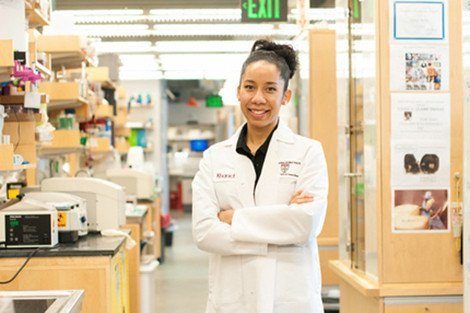May 28, 2013 — Khanichi Charles knows the value of mentoring. Without it, she wouldn’t have discovered her passion for scientific research, let alone apply to Harvard School of Public Health (HSPH). So despite long hours in the lab working towards her PhD in biological sciences, which she expects to earn in August, Charles makes time to be a role model for minority undergraduate students considering careers in science.
“As a minority student, you don’t have a lot of examples of people in research positions,” Charles said. “It’s not that you don’t think you’re capable of it; you just don’t see it as a possibility. It’s very important to me to be present and tell students ‘Don’t count yourself out.’”
Charles was introduced to research as a freshman at San Diego State University, where she was on the pre-med track. Through the federal Minority Biomedical Research Support (MBRS) and Minority Access to Research Careers (MARC) programs, Charles received not only funding that allowed her to spend more time in the lab pursuing biological research, but also an introduction to the life of a researcher, from conferences and poster presentations to publishing papers. The work fueled her scientific curiosity, particularly around metabolic diseases, and sent her career in a new direction. She has continued working with MBRS as a graduate student, returning each year to San Diego State to speak with current undergraduates in the program.
Now working in the lab of Gökhan S. Hotamisligil, J.S. Simmons Professor of Genetics and Metabolism and chair of the Department of Molecular Metabolism at HSPH, Charles is focused on elucidating the function of a protein found in fat that has been linked to metabolic disease. Mice that have had fatty acid binding protein (FABP) made inoperative in their genetic code no longer suffer the metabolic consequences of overeating, such as obesity, diabetes, and heart disease. Charles hopes to further understand FABP’s role in causing these diseases as well as aging-related health outcomes.
Charles entered HSPH with a passion to make discoveries that may someday help people, including members of her family, who are affected by metabolic diseases. She loves working in the lab and appreciates the “extremely collaborative environment” among the faculty and students in the department.
She also has taken full advantage of the technology available in the department. “My whole approach to science has changed since I’ve been here,” she said. “Anything that you can imagine experimentally, you have the resources to carry it out. I think that has allowed me to be more free and creative because I’m not hindered by what’s available.”
Charles sees herself working in an academic environment when she leaves HSPH, ideally continuing to pursue research and passing on her passion to the next generation of students.
Photo: Aubrey Calo
